All Images
News Release 10-134
These Crocs Were Made for Chewing?
Newly discovered, ancient crocodile was mammal-like, from its grinding molars to its skinny legs
This material is available primarily for archival purposes. Telephone numbers or other contact information may be out of date; please see current contact information at media contacts.
See what makes Pakasuchus kapilimai so special in this video feature.
Credit: Amanda Castroverde and Mackenzie Reed, National Science Foundation
Paleontologist Patrick O'Connor of Ohio University describes a newly discovered ancient crocodilian and its revealing place in the fossil record in an NSF webcast from Monday, Aug. 2, 2010.
Credit: National Science Foundation
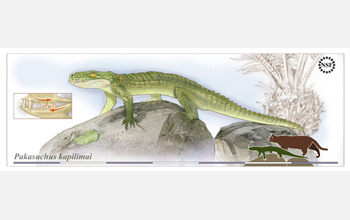
The ancient crocodile Pakasuchus kapilimai once roamed Tanzania in the Middle Cretaceous. No larger than a housecat, the animal had a number of features unusual for crocodylians, including mammal-like teeth.
Credit: Zina Deretsky, National Science Foundation
Download the high-resolution JPG version of the image. (709 KB)
Use your mouse to right-click (Mac users may need to Ctrl-click) the link above and choose the option that will save the file or target to your computer.
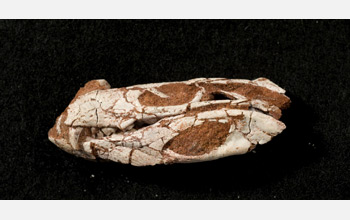
Left-lateral view of the skull of Pakasuchus kapilimai within its original red sandstone matrix.
Credit: Patrick M. O'Connor, Ohio University
Download the high-resolution JPG version of the image. (2.7 MB)
Use your mouse to right-click (Mac users may need to Ctrl-click) the link above and choose the option that will save the file or target to your computer.
Using a medical scanning technology called X-ray computed tomography, the researchers were able to create detailed digital images of the Pakasuchus teeth accurate to 45 micrometers (millionths of a meter). Because the images were digital, they were ideal for animation, enabling the researchers to observe how the teeth fit with one another and estimate how the jaw may have moved.
Credit: Patrick M. O'Connor, Ohio University
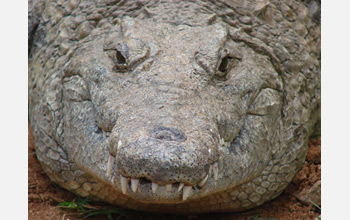
A Nile crocodile smiles for the camera in Queen Elizabeth National Park, Uganda.
Credit: Nancy J. Stevens, Ohio University
Download the high-resolution JPG version of the image. (462 KB)
Use your mouse to right-click (Mac users may need to Ctrl-click) the link above and choose the option that will save the file or target to your computer.
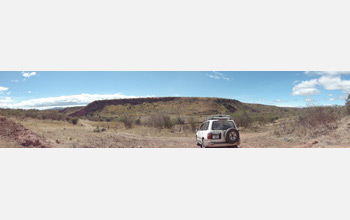
This panorama shows one of the research team's field vehicles on site in the Rukwa Rift Basin in Tanzania.
Credit: Patrick M. O'Connor, Ohio University
Download the high-resolution JPG version of the image. (2.7 MB)
Use your mouse to right-click (Mac users may need to Ctrl-click) the link above and choose the option that will save the file or target to your computer.
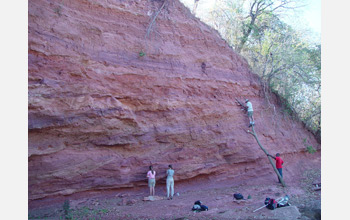
Patrick O'Connor and Sifa Ngasala excavate a dinosaur limb bone out of a cliff face on the Mtuka River.
Credit: Eric Roberts, James Cook University
Download the high-resolution JPG version of the image. (1.2 MB)
Use your mouse to right-click (Mac users may need to Ctrl-click) the link above and choose the option that will save the file or target to your computer.
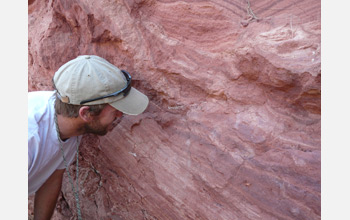
Patrick O'Connor examines the portion of exposed bone fragments that would ultimately yield the holotype specimen of Pakasuchus kapilimai. Coauthor and project student geologist Zubair Jinnah found the specimen while prospecting.
Credit: J.P. Cavigelli, Tate Museum, Wyoming
Download the high-resolution JPG version of the image. (2 MB)
Use your mouse to right-click (Mac users may need to Ctrl-click) the link above and choose the option that will save the file or target to your computer.
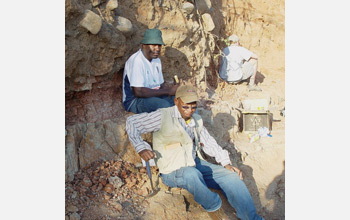
Saidi Kapilima (foreground, and for whom Pakasuchus kapilimai is named) and graduate student Sifa Ngasla (background) take a short break while hand-quarrying for fossils.
Credit: Patrick M. O'Connor, Ohio University
Download the high-resolution JPG version of the image. (700 KB)
Use your mouse to right-click (Mac users may need to Ctrl-click) the link above and choose the option that will save the file or target to your computer.


